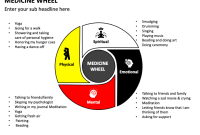What Is Medicine Wheel Owl?
The Medicine Wheel, also known as the Sacred Hoop, is a powerful symbol and spiritual tool used by various Indigenous cultures, particularly in North America. It represents the interconnectedness of all things and offers a framework for understanding the universe, oneself, and the journey of life. Within the Medicine Wheel’s teachings, the Owl holds a significant position, often representing wisdom, intuition, and the ability to see beyond illusions. This article explores the symbolism and significance of the Owl within the Medicine Wheel, delving into its role as a guide, protector, and a symbol of transformation.
The Structure of the Medicine Wheel
Before exploring the Owl, it is essential to understand the basic structure of the Medicine Wheel. While variations exist among different tribes and traditions, the core elements remain consistent. The Medicine Wheel is typically a circular arrangement, representing the cyclical nature of life, the seasons, and the universe. It is divided into four quadrants, each associated with a specific direction, element, color, and aspect of human experience.
-
<img src="https://cdn.britannica.com/56/240956-050-4EB4BFB0.jpg" alt="
- East: Represents the element of Air, the color Yellow, and the aspect of Illumination or Enlightenment. It is associated with new beginnings, inspiration, and the rising sun.
- South: Represents the element of Fire, the color Red, and the aspect of Trust or Emotion. It is associated with passion, courage, and the energy of growth.
- West: Represents the element of Water, the color Black, and the aspect of Introspection or Transformation. It is associated with endings, reflection, and the journey inward.
- North: Represents the element of Earth, the color White, and the aspect of Wisdom or Knowledge. It is associated with the ancestors, the lessons of experience, and the ability to see the truth.
What Is Medicine Wheel Owl?
” title=”
What Is Medicine Wheel Owl?
“>
Within each quadrant, there are further associations, including animals, plants, and teachings. These elements provide a deeper understanding of the lessons and energies within each direction.
The Owl in the Medicine Wheel
The Owl is most prominently associated with the West quadrant of the Medicine Wheel. This quadrant represents the element of Water, the color Black (or sometimes Blue), and the aspect of Introspection and Transformation. The Owl’s connection to the West is profound and multifaceted:
- Wisdom and Intuition: Owls are revered for their wisdom and their ability to see beyond the superficial. Their large eyes and nocturnal habits enable them to see in the darkness, symbolizing the ability to perceive hidden truths and unseen forces. The Owl encourages us to look beyond illusions and to trust our intuition.
- Transformation: The West is the direction of endings and transformation. The Owl represents the ability to navigate change, to release what no longer serves us, and to embrace the unknown. It reminds us that death and rebirth are essential parts of the life cycle.
- Seeing the Shadow: The Owl’s connection to the West allows it to understand the shadow self. This represents the parts of ourselves that we hide, the fears, and the unresolved emotions. The Owl encourages us to confront these aspects, to integrate them, and to find healing and wholeness.
- Messenger of the Spirits: Owls are often seen as messengers from the spirit world. They can act as a bridge between the physical and spiritual realms, carrying messages and offering guidance.
- Guardian and Protector: The Owl is a fierce protector, watching over those in need and guarding against negative energies. It reminds us to stand up for ourselves and to defend our values.
The Owl’s Symbolism Across Cultures
While the Owl’s significance within the Medicine Wheel is specific to Indigenous cultures, its symbolism transcends cultural boundaries. Across the world, the Owl has been revered and feared, embodying a range of qualities:
- Ancient Greece: The Owl was the sacred animal of Athena, the goddess of wisdom, warfare, and crafts. It was associated with knowledge, strategy, and the ability to see the truth.
- Celtic Tradition: The Owl was seen as a symbol of prophecy, wisdom, and the guardian of the Otherworld.
- Various Cultures: The Owl is associated with the night, the moon, and the hidden mysteries of life.
Working with the Owl in the Medicine Wheel
The Owl’s teachings within the Medicine Wheel can be applied to personal growth, spiritual practice, and understanding the challenges of life. Here are some ways to work with the Owl’s energy:
- Meditation and Visualization: Meditate on the Owl, visualizing its presence and asking for guidance. Imagine its large eyes, its silent flight, and its connection to the darkness.
- Journaling: Reflect on the areas of your life where you need wisdom, insight, or transformation. Write down your thoughts, feelings, and any insights that come to you.
- Seeking Guidance: Seek the advice of an experienced spiritual teacher or mentor who understands the Medicine Wheel and its teachings.
- Connecting with Nature: Spend time in nature, particularly in areas where owls are present. Observe the birds and their behavior, and allow their presence to inspire you.
- Embracing Change: The Owl reminds us that change is a natural part of life. Embrace the challenges and changes that come your way, and see them as opportunities for growth and transformation.
Conclusion
The Owl within the Medicine Wheel is a powerful symbol of wisdom, intuition, transformation, and spiritual guidance. It encourages us to look beyond the surface, to trust our inner knowing, and to embrace the cyclical nature of life. By connecting with the Owl’s energy, we can gain a deeper understanding of ourselves, the world around us, and our place within the vast tapestry of the universe. The Owl serves as a reminder that the journey of life is a journey of continuous learning, growth, and transformation.



